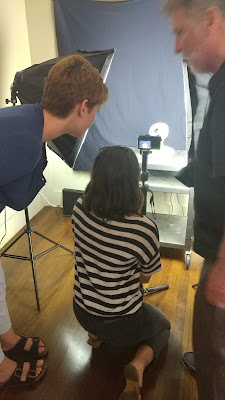Conversations about Conferences (and Workshops!): PIN/NCPTT Photogrammetry Workshop
 |
| Emily Jane and Nicole doing image capture |
EJM: What did you expect in attending the Photogrammetry Workshop?
EED: I honestly expected to walk out with the ability to make a basic model. I never thought that I would walk away with the knowledge of the history of photogrammetry, physical guides, and the ability to make measurable models!
EED: What did you hope to get out of it?
EJM: Well, I hoped to learn a little more about how to do photogrammetry. I've had a few informal crash courses in the topic from colleagues, but never felt that comfortable with the process. I've made a few good models but had lots of bad ones as well. I wanted to get proficient enough that I could easily create models, without huge errors and issues.
EED: I was hoping to actually learn about photogrammetry period! My understanding of photogrammetry came from watching YouTube videos for a few hours, nothing that would make me capable of filling Kevin's very large shoes! I was just hoping to be able to create one
EED: So what did you actually learn?
EJM: I certainly learned a lot! I think the most interested bits I learned was the history of it all. The modern idea of photogrammtery has it's routes in using photographs with known scale to get measurements of objects. The first use of the technic is credited to Albrecht Meydenbauer. He published an article in the Berlin Architectural Society's weekly journal in 1867 discussing the use of photographs to measure building dimensions for a survey of Berlin, something he developed after he fell from the roof of a church while trying to measure in person.
EJM: What was the hardest part of attending the workshop?
EED: I think the hardest part for me was technical difficulties! My laptop battery wouldn't keep a charge and I was having issues with my licence for the software! The people at AgiSoft became close friends, they were seriously amazing when trying to help me get my licence back so I could do all the steps!
EED: What will you bring back for the public for their benefit?
EJM: ALL OF THE MODELS!
 |
| Emily Jane's model of a dinosaur bone created at the workshop. |
I hope to make Florida archaeological sites and artifacts more accessible to people using the technology. I've already modeled the oldest stone in Hibernia Cemetery over in Fleming Island.
EED: Ditto, minus the already completed model. Emily Jane is more on top of her modeling practice than I am!
EJM: What activities did you do, with the workshop or in Nantucket?
 |
| Emma and Nicole capturing images of the cottage to create our model. |
I was also ecstatic to be able to visit Nantucket! I grew up learning about the Whaling industry and was just happy to walk around the harbor front.
EJM: Most of the workshop was spent in the classroom, going through tutorials and listening to lectures about the process. We did get into the field to capture photos of some cottages that were slated for demolition - part of a larger documentation project for the Preservation Institute.
But when I had a bit of downtime, I made it to the Whaling Museum and a few other historic sites. Nantucket is one of the most in-tact historic maritime communities in the United States, so I couldn't help but do some site-seeing!
 |
| Tom Noble instructing students how to capture images for a model. |
EJM: While I knew the workshop would be excellent given the hosts, I had no idea the instructors would be two of the pioneers in the field! Both Neffra and Tom had such a wealth of knowledge - and were so gracious with sharing their expertise - that I know I got the best crash course in the subject that I could have.
EED: I would have to agree! I never expected the workshop to be hosted by Neffra and Tom. The wealth of information those two have on the subject is crazy!
EED: Future plans?
EJM: As I mentioned, I wanted the process to become easier so I could create more models. Emma, Nicole and I set a pack to create at least 1 model a week, so I have a lot to work on!
EED: Emily Jane is on the ball with the modeling. Although I hope to do a model a week. I think it might be more like a model a month?
Words and Images by Emily Jane Murray and Emma Dietrich, FPAN Staff.